#Giulio II
Explore tagged Tumblr posts
Text
Pene d'amore
Sono sempre stato innamorato ed ho sofferto le pene dell’inferno su questa terra. Ho dedicato dolorosi versi alle mie pene e questo che vi riporto a seguire forse è quello che meglio descrive quale sia stato il mio stato d’animo per tutto il corso della vita. Fuggite, amanti, Amor, fuggite ‘l foco; l’incendio è aspro e la piaga è mortale, c’oltr’a l’impeto primo più non vale né forza né…

View On WordPress
#affreschi#arte#Cappella Sistina#dipinti#disegni#Giulio II#ignudi#Michelangelo Buonarroti#Vaticano#versi
3 notes
·
View notes
Text
The Thought by Giulio Monteverde

#The Thought#Minerva#Statue#Bronze#Sculpture#Giulio Monteverde#Vittoriano#Altare della Patria#Statua Il Pensiero#Art#Victor Emmanuel II#Monument#Piazza Venezia#Rome#Italy
113 notes
·
View notes
Text
youtube
"Avec cette chanson, je ne pense plus à la malchance et au malheur"
Merci Sch
JVLIVS: Giulio va arriver
1 note
·
View note
Text


listen. listen, there's a kind of intimacy in having a dedicated rivalry, okay. who else is going to know you like this!!! also it's funny

Ascanio Maria Sforza: la parabola politica di un cardinale-principe del Rinascimento, Marco Pellegrini

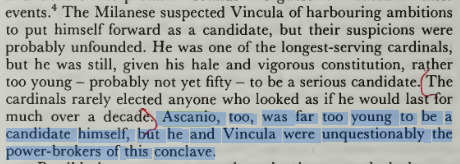
Julius II: The Warrior Pope, Christine Shaw
and on della rovere’s soldier comment:
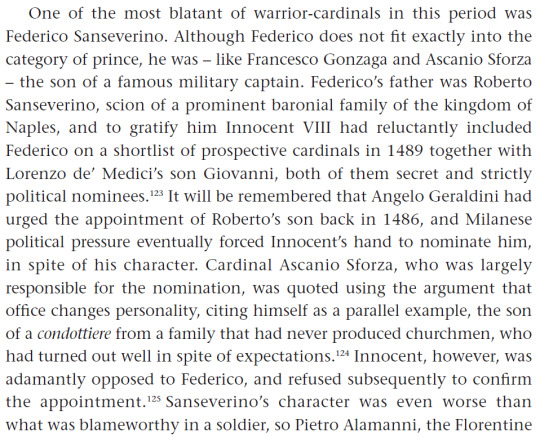
Popes, Cardinals and War: The Military Church in Renaissance and Early Modern Europe, D.S. Chambers
and finally! regarding the delightful Mess of political-family relationships, including the marriage comment (altho the montefeltro family that giovanni married into did have sforza family ties, since giovanna's mother was battista sforza, but this is about the more immediate alliance based relationship and della rovere's hand in the rejection of a milanese match for his brother. and. this is not even remotely a serious comic, but now I am once again thinking about insular all these families are. the fucking medicis are here too, if you go half a step to the left on della rovere's family tree)

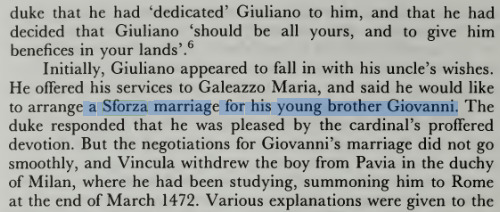
Julius II: The Warrior Pope, Christine Shaw
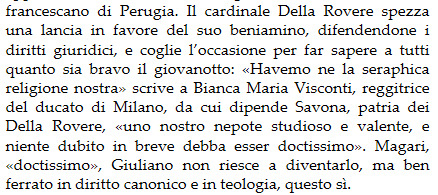
Giulio II, Il papa del Rinascimento, Giulio Busi (Bianca Maria Visconti is Ascanio's mom. btw)
panel inserts of the cards they're playing with are all from the Visconti-Sforza tarot deck! (I used public domain scans/photos for the comic itself)
ko-fi!⭐ bsky ⭐ pixiv ⭐ pillowfort ⭐ cohost ⭐ cara.app
#weeping. ascanio's dialogue covers up della rovere's sleeve collar. i spent all that time drawing details on it and FOR WHAT#(it was fun)#there was another deleted bit where ascanio has some petty line like 'i bet arguing makes you hard' but then i realized#that's something that lucullus would probably say to crassus and also i need to set that line up for ascanio#we gotta. we gotta character build (lays down face in the ground) we have to provide the character set up for it#it's really more of a line for cesare to drop at some point over how much rodrigo and ascanio argued#shout out to the time rodrigo threatened to throw ascanio into the tiber river or that time ascanio like. decided to physically get into#a fight with juan borgia#and they were still gambling partners after that????? damn okay. sometimes the vice chancellor can be (checks note) im not finishing#that statement#komiks tag#italian renaissance tag#ascanio sforza#giuliano della rovere#i WILL get a relationship dynamic tag for them once i can figure out something punchy and fun. anyway!#ehgh. I NEED. to go to milan. and go thru the archives. let me in. LET ME INNNNNNNNN
292 notes
·
View notes
Text

Thinking about them (Julius II and Giulio de' Medici)
45 notes
·
View notes
Text

Wedding of Maria de' Medici and Henry IV of France
Description: Maria de Medici's marriage by proxy with Henry IV of France, represented by Ferdinand I, Grand Duke of Tuscany.
Artist: Jacopo da Empoli (Italian, 1551–1640)
Date: 1600
Medium: Oil on canvas
Collection: Uffizi Gallery, Florence, Italy
Wedding of Maria de Medici
Marie de Medici became queen of France upon marrying King Henri IV in October 1600. She was his second wife. Henri had annulled his first marriage to Marguerite de Valois after converting to Catholicism in 1593. This was not the first union of French royalty and the powerful Florentine family; in fact Marguerite de Valois was one of the children of Catherine de Medici and Henri II of France, who had married in 1533. Marie was distantly related to Catherine and Marguerite, as she was descended from a different line of the Medici family.
The wedding of Henri IV and Marie de Medici was a proxy wedding, the term used when the bride or groom is not physically present for the marriage ceremony. Marie de Medici's uncle, Ferdinando, Grand Duke of Tuscany, (who had arranged the match) stood in for Henri IV at the ceremony in Florence. The Medici family members were renowned patrons of the arts, and Ferdinand was no exception: the nuptials were marked by a performance of the newly-invented dramatic art form of opera (Eurydice by Jacopo Peri and Giulio Caccini). Marie would have grown up well accustomed to artistic patronage through knowledge of the Medici family's collections and commissions.
#portrait#marriage#painting#oil on canvas#fine art#marriage ceremony#marie de medii#house of medici#king henry iv#queen of france#french monarchy#french empire#jacopo da empoli#french painter#french culture#costume#wedding ring#men#women#1600#17th century painting#artwork#french art
24 notes
·
View notes
Text
The Dionysos gallery (1)
I wanted to conclude my long series of Dionysos posts with a collection of Dionysos and Bacchus paintings that were carefully collected by the website of the French Museum of Wine! (Only in France can you have a museum of wine be a normal thing)
First we have an entire section about Dionysos himself. The page is here if you are interested.
I/ Dionysos as a child and a teenager

Giulio Romano's The Birth of Bacchus

Laurence de la Hyre's Mercury entrusting Bacchus to the Nymphs
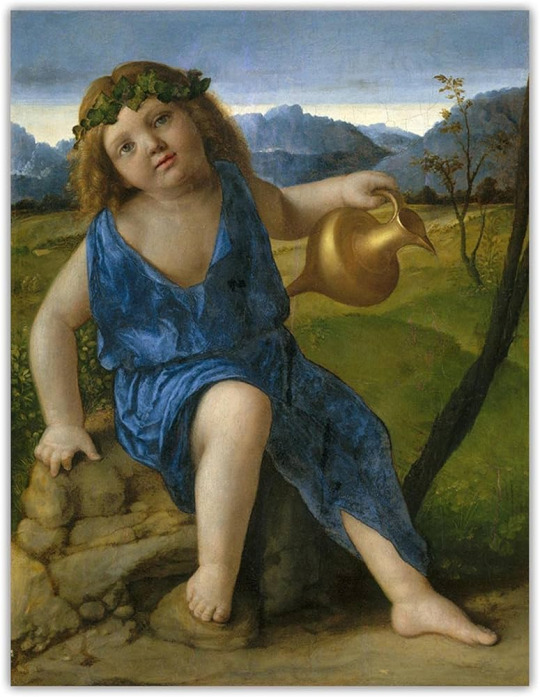
Giovanni Bellini's Child Bacchus
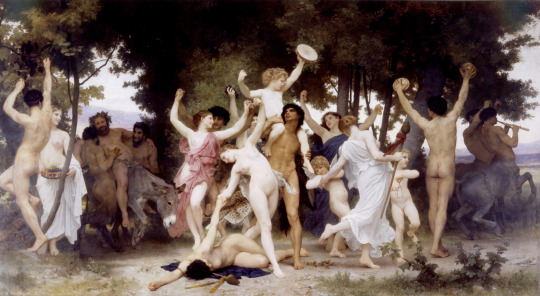
William-Adolphe Bouguereau's The Youth of Bacchus

Caravagio's Bacchus

Caesar van Everdingen's Nymphs offering wine, fruits and flowers to the young Bacchus
II) Bacchus as a god

Titien's Bacchus and Ariadne

Guido Reni's Bacchus and Ariadne

Brothers Le Nain's Bacchus discovering Ariadne at Naxos
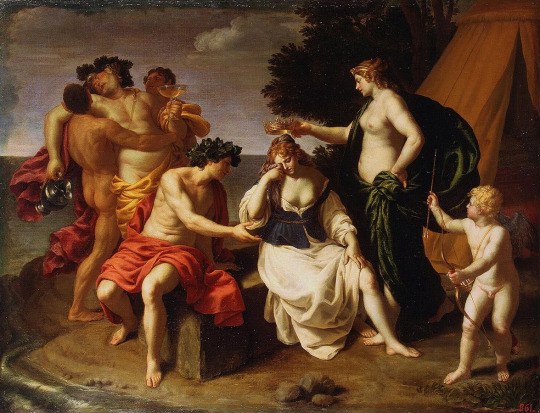
Alessandro Turchi's Bacchus and Ariadne

Caesar van Everdingen's Bacchus with two nymphs and Cupid

Charles de la Fosse's Bacchus and Ariadne

Jean-François de Troy's Bacchus and Ariadne

Sebastiano Ricci's Bacchus and Ariadne
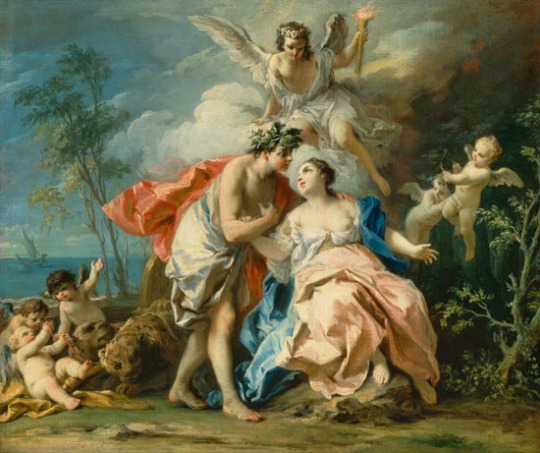
Jacopo Amigoni's Bacchus and Ariadne

Bartolomeo Manfredi's Bacchus and a drinker
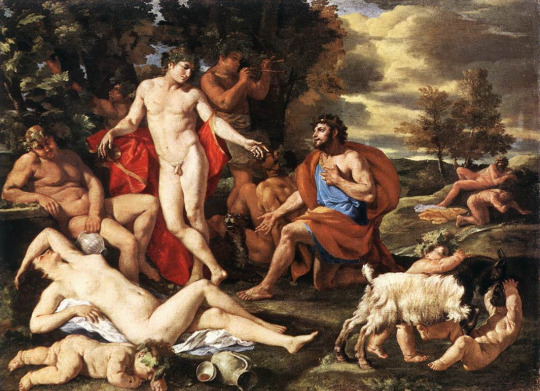
Nicolas Poussin's Midas and Bacchus
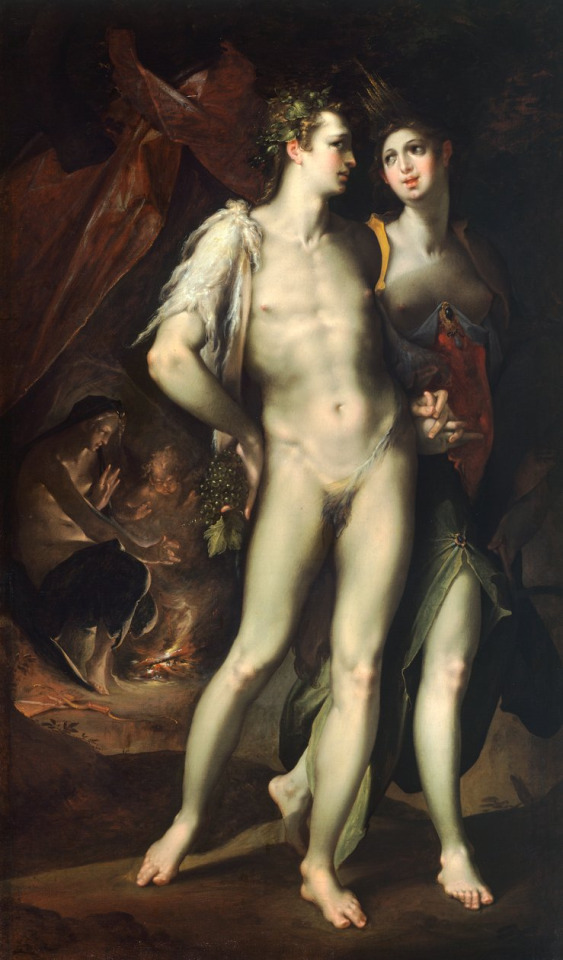
Bartholomaus Spranger's "Sine cerere et baccho friget venus", also known as Bacchus and Ceres

Louis de Caullery's Venus, Bacchus and Ceres dancing with mortals in a garden of love

Hans von Aachen's Bacchus, Ceres and Cupid

Bon Boullogne's Venus, Bacchus and Ceres

Sebastiano Ricci's Bacchus and Ceres

Maurice Dennis' Bacchus and Ariadne
#the art of the myth#dionysos#dionysus#greek god#greek mythology#ariadne#demeter#paintings#painting#art#museum#ceres#bacchus
77 notes
·
View notes
Text
Francisco de Peñalosa (c.1470-1528)
Missa Nunca fue pena mayor [(142v—150) E-TZ Archivo Ms. 2/3. Archivo Capitular de la Catedral, Tarazona, Spain]
– Kyrie – Gloria – Credo – Sanctus – Agnus Dei.
– Ave vera caro Christi Ave vera caro Christi, / qui in cruce pependisti, / cuius Patri tu dixisti: / ut quid me dereliquisti? // Salve sancta caro Dei, / per te salvi fiunt rei, / tuum servum redemisti, / dum in cruce pependisti. // O Jesu pie, o dulcis fili / virginis Mariae, / miserere nobis. //
Julius de Modena (Giulio Segni) (1498-1561).
– Tiento XIX. (Otro quarto tono Iulius demodena). – Segundo tres
Libro de cifra nueua para tecla, harpa, y vihuela, en el qual se enseña breuemente cantar canto llano, y canto de organo, y algunos auisos para contrapunto / compuesto por Luys Venegas de Henestrosa, dirigido al illustrissimo señor don Diego Tauera, obispo de Iaen. [Alcalá de Henares: Joan de Brocar, 1557].
Francisco de Peñalosa – Missa Nunca fue pena mayor. Les Sacqueboutiers, Ensemble Gilles Binchois, Dominique Vellard. (2011, Glossa – GCD 922305)
#francisco de peñalosa#renaissance#sacred#mass#kyrie#credo#gloria#sanctus#agnus dei#choir#julius de modena#tiento#motet
17 notes
·
View notes
Text

Torquato Fasso and Eleanore D'Este
Artist: Felice Schiavoni (Italian, 1803-1881)
Genre: Portrait
Date: 1839
Media: Oil on Canvas
Collection: Private Collection
Felice Schiavoni
Felice Schiavoni was an Italian painter, depicting history, genre, and portraits. During his early career, he often collaborated with his father, the painter Natale Schiavoni.
Felice was born in Trieste. He was first a pupil of his father, and he then studied at the Brera Academy at Milan, where he won a prize, and later at Venice and Vienna. He was awarded a prize and medal by Emperor Nicholas of Russia.
He often painted in Venice for Russian patrons. Among his works are a Death of Raphael Sanzio painted during a period of 15 years for Emperor Alexander II of Russia, and for which he was paid 60 thousand Lire. The large canvas was an scholarly tour-de-force which included 16 portraits of famous Italian artists, assembled to grieve at the bedside of the dying painter, including Pierin del Vago, La Fornarina, Giulio Romano, Andrea Navagero, Cardinal Pietro Bembo, Ludovico Ariosto, Michelangelo, and Benvenuto Cellini.
He also painted a Miracle of St. Anthony of Padua and a Saints Simon Stock and Anthony of Padua for a church in Trieste; a Raphael and the Fornarina for the Tosi Gallery, Venice ; a Cupid for the Brera Gallery in Milan; a Christ bearing the Cross ; a Christ Asleep; a Torquato Tasso reading to Eleonora; a Repose in Egypt (1824); a Venus and Cupid (1832); a Madonna (1854) ; a Raphael painting the Fornarina (1861); and a Holy Family (1864).
His wife, Regina Sfriza, died soon after Felice. His daughters Carolina and Julia were also painters, the former of landscapes, the latter of history and portraits. His brother Giovanni (1804–48) was also painter of mythology and history.
#oil painting#history#fine art#reading time#books#italian art#portrait#oil on canvas#painting#felipe schiavoni#italian painter#italian culture#sitting#chair#interior#conversation piece#european art#costume#man#woman#artwork#rug#wallpaper
14 notes
·
View notes
Text
My favorite headcanons about the Di Angelo family. I have a genuine interest in them, so please bear with me!
Maria di Angelo was born in 1909 and met Hades and Persephone in 1932, during a party at the Italian embassy in the US. She had Bianca in 1933, and Nico in 1935 (I refuse in any way Rick's idea that the two were born at the end of the 20s, it doesn’t make with the timeline, but when does it make sense?)
She had an older brother, Michele, who was born in 1907, a younger sister, Elisabetta, born in 1919, and an older cousin, Giulio, born in 1908
Giulio went to live with them after the death of his father during WW1 because he was already an orphan of his mother, who died during childbirth. They grew up all together
These four kids didn't have many friends, except for the Adriani siblings, Alessandro (1906) and Vittoria (1909, but younger than Maria)
The Adriani are from both Naples and Rome (because of an arranged marriage), while the Di Angelo are from around Venice
The two families became friends because the two fathers met during the war and continued to see each other after the end of it because they both went into politics. The Di Angelo's became an ambassador, while the Adriani's a senator
During her adolescence, Maria had a little crush on Alessandro, but he always saw her as a little sister
Maria had a relationship with both Hades and Persephone but decided to cut it after Nico's birth, not because she wanted to but to protect her children from her father and older brother
She and Alessandro got married, to help her, but also to hide the relationship between Alessandro and Giulio (it was her idea, and she knows everything). They got married in 1937
Vittoria is Maria's best friend and always supported her
Ironically, I think Di Angelo's flower symbol is a white chrysanthemum, and Maria gave one to Michele before he went to Russia
All the family died during the war, while the Adriani siblings survived and are the only ones who remember them as people and not as symbols
The two parents died a few months before Italy's entrance into the war, Giulio and Elisabetta both died of pneumonia in 1942 (early year), while Michele died of hypothermia in Russia during the retreat (1943). Maria died because of Zeus, obv (in 1944)
Nobody in Italy knows what happened to Maria and her kids, even though Alessandro and Vittoria tried to find them. They became some sort of urban legend
Alessandro was sent to Africa during the war, hoping to see them again once he returned, but that never happened
Plus, I think Hades amplified Maria's sight. You know, when mortals can see over the Mist? Yeah, Maria could manipulate also her dreams, but this led her to make some sort of contact with Naomi Solace. The two of them started to see each other every night, and both of them started to develop some feelings for each other, a mix of eros and agape, something like that
Some of Naomi's songs are about her, like "Girl of the Forest" or "Fallen Angel" (I know, they are cringe titles, I'm very sorry!)
Naomi still dedicates some songs to Maria, even though she knows she's not here anymore
Plus, during HoO, when Argo II is in Venice, Nico, Hazel, and Frank meet a group of friends who are wandering in the city. They are very similar physically to Nico's relatives and one girl in particular reminds him of Maria. They aren't their reincarnations, but they are similar to them. This girl is also obsessed with Naomi's music and Di Angelo's story
And those are my main headcanons about them, right now I cannot think of others, but if I have others, I will share!
#percy jackson#maria di angelo#nico di angelo#bianca di angelo#hoo#percy jackson and the olimpyans#pjo#pjo fandom
27 notes
·
View notes
Text
Papa Giulio II: meglio essere temuto che amato
Papa Giulio II, al secolo Giuliano della Rovere, è sempre stato considerato come un pontefice dalla grande personalità, terribile insomma. Lo storico dell’arte Alessandro Luzio, vissuto a cavallo dell’Otto e del Novecento, ebbe modo di raccontare qualcosa di insolito del carattere di Giulio II mediante il ritrovamento di un dispaccio risalente al 1510 inviato da un suo fedelissimo da Bologna,…

View On WordPress
#arte#bellezza#Bologna#capolavoro#cappellasistina#english#Giulio II#inartwetrust#life#madeinitaly#masterpiece#Rovere#storytellig#storytelling
2 notes
·
View notes
Text

Sleep Space 2
19.08.2024
Sleep Spaces
Hey everyone,
A series of ambient mixes designed to help you unwind and drift off into a peaceful sleep. As someone who struggles with sleep deprivation, I know firsthand the power of ambient music to create a calming atmosphere.
I’ve curated a collection of what I believe are particularly positive and soothing ambient pieces, weaving them together into roughly two-hour mixes. The goal is to provide a consistent and relaxing soundscape to help you relax and prepare for a good night’s sleep.
Sweet dreams! Trevor
Sleep Space 1
Ishqmatics-Aqua Dub 00:00 Luke Sanger-Monday Misfit 11:08 David Cordero, Rhucle-Beyond the Horizon 15:52 Thrupence-The Difference (Original by Flume & Toro y Moi) 19:18 Sam Rosenthal-leading to the edge 25:38 Go Outside-not far away 26:39 Dark Fidelity Hi Fi-Outcodes 29:29 Christopher Willits, East Forest-Tunnels – East Forest Remix 31:17 anthéne-monochrome (awakened souls rework) 35:06 JB Dunckel-Égérie 38:53 From Overseas, zakè, Chihei Hatakeyama, Hakobune-Live Improvisation II – Live 41:53 Lesjamusic-Lesjamusic is Lost 1:02:32 Kenneth James Gibson-The Art Of Forgetting Yourself – Awakened Souls Remix 1:06:08 Giulio Stermieri-Wide Plain, Desolate Place 1:09:52 Ann Annie-Cottonwood 1:15:39 Paperbark-Faint Roads 1:17:40 Ed Herbers-Cruising Altitude 1:23:35 The Green Kingdom-Arcadian Skies 1:29:59 Tim Linghaus-Poplars In Your Eyeball 1:34:17 The Green Kingdom-Softly Away 1:37:06 No Death, Rhucle-Twilight Mood 1:41:09
Sleep Space 2 synkrotron-Pallas 00:00 Socool & Ireless-Ground 09:50 Francesca Heart-Circular Motion of the Nine Muses 11:58 Paul Cousins-Improvisation for 3 Tape Loops 15:32 Binaural Space-Use Your Illusion 30:20 Garden Gate-The Overground Church 35:19 Francesca Heart-Angelsummit.net 36:50 Time Rival-Pumice 41:36 Rhucle-Holy 46:08 Maps and Diagrams-An8kh 48:35 Lionmilk, Club Diego-Delagation of Delights 49:55 Willebrant-Sands l (New Light) 56:00 Viul-Eighties 59:03 Paper Relics-I Know The Way 1:01:05 Chris Russell-Forever In Blue 1:04:07 Paperbark-Antique Correspondence 1:13:00 Mark Ellery Griffiths-I sailed to meet her 1:19:57 Multi-Surface-Wrinkled Smile 1:22:58 Bvdub, Inquiri-Please Let Go and Let Me Hold You 1:25:40 Letters from Mouse-Piglet 1:44:45
#synkrotron#Socool & Ireless#Francesca Heart#Paul Cousins#Binaural Space#Garden Gate#Time Rival#Rhucle#Maps and Diagrams#Lionmilk#Club Diego#Willebrant#Viul#Paper Relics#Chris Russell#Paperbark#Mark Ellery Griffiths#Multi-Surface#Bvdub#Inquiri#Letters from Mouse#Dragon_Trax#LEAVING RECORDS#Clay Pipe Music#Handstitched*#Neotantra#Dauw#whitelabrecs#Projekt Records#Seil Records
7 notes
·
View notes
Text
“La abundancia de las cosas, aunque sean buenas, hace que no se estimen, y la carestía, aun de las malas, se estima en algo”
Miguel de Cervantes
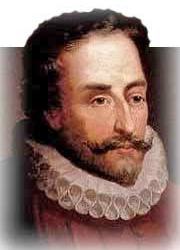
Fue un novelista, poeta, dramaturgo y soldado español, nacido en Alcalá de Henares en septiembre de 1547, ampliamente considerado como una de las máximas figuras de la literatura española.
Su padre se llamaba Rodrigo Cervantes y su madre Leonor de Cortinas, de quienes poco se sabe de sus vidas. Se asume que nació el 29 de septiembre dado que en ese tiempo se acostumbraba darle el nombre a los niños por el dia de su nacimiento, siendo la fiesta de San Miguel Arcángel ese día.
Tampoco existen datos precisos sobre los primeros estudios de Miguel de Cervantes, que sin duda no llegaron a ser universitarios, por lo que se asume, pudo haber estudiado en Córdoba o Sevilla.
En 1566 se estableció en Madrid, era amante del teatro y asistía a las representaciones de Lope de Rueda, un dramaturgo español de gran versatilidad.
Sin tener confirmación de si se trata de un homónimo, existe una providencia de Felipe II que solicita la aprehensión de Miguel de Cervantes por herir a un obrero en un duelo, situación que podría justificar su estancia en Italia, algunos autores como Ludovico Ariosto o León Hebreo influirían en el Don Quijote.
En Italia se pone al servicio de Giulio Acquaviva, un eclesiástico italiano a quien le siguió por Palermo, Milán, Florencia, Venecia, Parma y Ferrara. Después de ello ocupó una plaza como soldado en la compañía del Capitán Diego de Urbina del tercio de Miguel Moncada, en donde participó en la batalla de Lepanto en octubre de 1571.
Derivado de la batalla de Lepanto, Miguel de Cervantes pierde el movimiento de su brazo izquierdo cuando un trozo de plomo le seccionó un nervio, de donde adquiere el apodo de “El manco de Lepanto”.
Cervantes reanuda su vida militar en 1572, formando parte en multiples expediciones navales y recorriendo las principales ciudades de Sicilia, Cerdeña, Génova y la Lombardía.
Durante su regreso desde Nápoles a España, Cervantes es hecho prisionero y tomado en cautiverio y llevado a Argel, en donde solicitarían un rescate de 500 escudos de oro, pues creían que se trataba de una persona muy importante para el reino derivado de unas cartas de recomendación que poseía.
En casi 5 años de aprisionamiento, Cervantes intentó escapar en 4 ocasiones sin éxito, y es ahi, en donde se piensa que surgió un parteaguas entre su vida y la literatura, hasta que en septiembre de 1580, Cervantes es liberado regresando por fin a España, en donde esta experiencia vería reflejada en sus trabajos titulados; “El trato de Argel”, “La Galatea”, y en “Los trabajos de Persiles y Sigismunda”.
Es muy probable que entre los años 1581 y 1583, Cervantes escribiera “La Galatea”, su primer obra literaria en volumen y trascendencia.
Cervantes se establece en Sevilla en 1587 en donde fue comisario de abastos de los barcos reales, los cuales le causaron multiples problemas con los campesinos, pues los impuestos que recaudaba básicamente eran para cubrir las deudas de la guerra, sin embargo esto le permitió conocer el abigarrado y pintoresco mundo del campo, el cual reflejaría magistralmente en el Quijote.
En 1597 Cervantes es encarcelado tras sospecha de malos manejos en las cuentas que administraba para recaudar impuestos y es en la cárcel, en donde engendra la primera parte de su célebre novela “Don Quijote de la Mancha”, según prólogo de esta obra. No se sabe a ciencia cierta si con ese término quiso decir que comenzó a escribirlo mientras estaba preso o simplemente que la idea se le ocurrió en prisión.
La primera parte de su obra “El ingenioso hidalgo, Don quijote de la Mancha” apareció en 1605; en donde el éxito de este libro fue inmediato y considerable, sin embargo poco le sirvió para salir de la miseria.
Mientras los grandes poetas del siglo de oro como Francisco de Quevedo, Lope de Vega o Luis de Góngora gozaban de una sólida posición y de la protección de la aristocracia, Cervantes tenía que seguir a la Corte a donde se estableciera para poder seguir mendigando favores. La difusión del Quijote solo le sirvió para publicar otras obras que ya tenía escritas como Las Novelas Ejemplares, el Viaje del Parnaso y Comedias y Entremeses.
En 1615, meses antes de morir, envió a la imprenta el segundo tomo del Quijote, completando la obra que lo situaría como uno de los mas grandes escritores de la historia y como el fundador de la novela en el sentido moderno de la palabra.
Cervantes murió en Madrid a la edad de 68 años de diabetes. Su cuerpo fue enterrado en el convento de las trinitarias descalzas, ya que cuando fue llevado preso a Argel, fue la congregación de los trinitarios quienes ayudaron a pagar su rescate, recogiendo fondos para que el y su hermano Rodrigo fueran liberados.
Fuente: Wikipedia y biografiasyvidas.com
#españa#siglo de oro#escritores#novelistas#citas de escritores#frases de reflexion#frases de escritores#dramaturgos#citas de poetas#frases de poetas#poetas en español#poetas
8 notes
·
View notes
Text


Archaeologists Discover Electoral Inscriptions in Pompeii
The signs found encourage voting for a certain Aulus Rustius Verus for the post of Aedile, the councilman in charge of public works.
One autumn day in 79 A.D., Vesuvius’s fury stopped the clock in Pompeii and left the ancient Roman city frozen in time forever. Searching through the ashes, archaeologists working on the new batch of excavations have traveled back to the time before the volcano erupted and discovered some election inscriptions that prove that political maneuvering in antiquity was not unlike today; they have also found what was probably the last ritual offering to the gods before the devastating eruption. For researchers, the new discoveries are treasures that help figure out the details of what daily life was like in ancient Rome.


Inside a house, which has only partially been excavated, on the Via di Nola in the central area of ancient Pompeii, several electoral inscriptions — the ancient equivalent of today’s electoral posters and brochures — have appeared on the walls of the room that housed the lararium, the house’s domestic altar.
It was surprising to find these inscriptions inside the house, since they were normally put on the buildings’ exterior facades, where citizens could read the names and good attributes of the candidates for the city’s courts.
Archaeologists explain that the electoral ad was inside the house because it was common practice to organize events and dinners inside the homes of the candidates and their friends to promote their electoral campaigns.
In this case, the signs encourage voting for a certain Aulus Rustius Verus for the post of aedile, a kind of councilor who was responsible for public works in ancient Rome. This figure appears in other inscriptions and is known in Pompeii for having held the city’s highest public office, duoviri — the position to which one acceded after having been an aedile — in the 70s of the first century A.D. In ancient Rome, duoviri were magistrates who were elected in pairs so that they could control and advise each other, as well as supervise the city’s public, political and administrative offices. Aulus Rustius Verus held the position along with Giulio Polybius, who owned a splendid house on the Avenue of Plenty. Consequently, archaeologists deduce that the newly discovered inscriptions are older and that Aulus Rustius Verus probably won the elections mentioned in them.



Apparently, the house belonged to an Aulus Rustius supporter, perhaps one of his freedmen or a friend, and it contains a detail of note for archaeologists: a bakery with a large oven, near which the bodies of three victims, two women and a child, who were killed by the attic’s collapse during the first phase of eruption. The remains were discovered just a few months ago.
According to experts, the bakery’s presence reveals that political patronage — which, like today, consisted of promising favors in exchange for votes — was the order of the day in antiquity.
Maria Chiara Scappaticcio, a professor of Latin at the Federico II University in Naples, Italy, and the co-author of the study in which the new findings appear, explained that councilors and bakers “collaborated to the limits of legality,” and that Aulus Rustius Verus “could have realized very early on, when he was still in the midst of the election campaign to become a councilor, that, above all, the voter lives on bread.”
The discovery of the candidate’s initials, A.R.V., on a volcanic millstone leaning against the house entrance hall, where renovation work was being performed at the time of the eruption, supports that thesis. “Aulus Rustius Verus probably financed the bakery’s activity directly, both for economic and political purposes,” Maria Chiara Scappaticcio noted.


In addition, the remains of a last votive offering were found on the altar of the great lararium, which was decorated with two stucco snakes; the offering was probably made shortly before the eruption. Researchers have analyzed the remnants and discovered that the ritual consisted of offering figs and dates that were burned in front of the altar. To bring the rite to a close, a whole egg was placed directly on the lararium’s masonry altar. The altar was then covered with a tile. The remnants of earlier offerings were also found; they included fruits of the vine, fish and mammal meat.
The director of the Pompeii Archaeological Park, Gabriel Zuchtriegel, emphasized that each new archaeological find is shared practically in real time, through an electronic diary that they publish on the park’s website, as the excavation phase continues. “To my knowledge, we are the world’s first archaeological site to practice this form of scientific transparency: we are convinced that, in this way, Pompeii will be an international model for a new type of data accessibility because of the opportunities that digital technologies offer. The future of archaeology is here,” he said.
By LORENA PACHO.



#Pompeii#Archaeologists Discover Electoral Inscriptions in Pompeii#Aulus Rustius Verus#Mount Vesuvius#ancient political siigns#ancient artifacts#archeology#archeolgst#history#history news#ancient history#ancient culture#ancient civilizations#roman history#roman empire
41 notes
·
View notes
Text

Portrait of Margherita Paleologa
Artist: Giulio Romano (Italian, 1499–1546)
Date: c. 1531
Medium: Oil on panel
Collection: Royal Collection Trust, United Kingdom
Margaret Paleologa
Margaret Palaeologa (Italian: Margherita Paleologa; 11 August 1510 in Casale Monferrato – 28 December 1566 in Mantua), was the ruling Marquise regnant of Montferrat in her own right between 1533 and 1536. She was also Duchess of Mantua by marriage to Federico II, Duke of Mantua. Margaret acted as the regent of the Duchy of Mantua twice during the minority of her sons: for her elder son Francesco III Gonzaga, Duke of Mantua in 1540-1549, and for her younger son Guglielmo Gonzaga, Duke of Mantua, between 1550 and 1556.
#portrait#margherita paleologa#marquise of montferrat#interior#three quarter length#armchair#costume#embroidery#women#gold necklace#pearl earrings#oil on panel#artwork#fine art#italian culture#italian art#oil painting#house of palaeologus-montferrat#byzantine empire#ancient rome#ancient roman history#giulio romano#italian painter#16th century painting#european art#royal collection trust
21 notes
·
View notes
Text
The Top 40 Most Popular Operas, Part 3 (#21 through #30)
A quick guide for newcomers to the genre, with links to online video recordings of complete performances, with English subtitles whenever possible.
Verdi's Il Trovatore
The second of Verdi's three great "middle period" tragedies (the other two being Rigoletto and La Traviata): a grand melodrama filled with famous melodies.
Studio film, 1957 (Mario del Monaco, Leyla Gencer, Ettore Bastianini, Fedora Barbieri; conducted by Fernando Previtali) (no subtitles; read the libretto in English translation here)
Donizetti's Lucia di Lammermoor
The most famous tragic opera in the bel canto style, based on Sir Walter Scott's novel The Bride of Lammermoor, and featuring opera's most famous "mad scene."
Studio film, 1971 (Anna Moffo, Lajos Kozma, Giulio Fioravanti, Paolo Washington; conducted by Carlo Felice Cillario)
Leoncavallo's Pagliacci
The most famous example of verismo opera: brutal Italian realism from the turn of the 20th century. Jealousy, adultery, and violence among a troupe of traveling clowns.
Feature film, 1983 (Plácido Domingo, Teresa Stratas, Juan Pons, Alberto Rinaldi; conducted by Georges Prêtre)
Part I, Part II, Part III, Part IV, Part V, Part VI
Mozart's Die Entführung aus dem Serail (The Abduction from the Seraglio)
Mozart's comic Singspiel (German opera with spoken dialogue) set amid a Turkish harem. What it lacks in political correctness it makes up for in outstanding music.
Royal Opera House, Covent Garden, 1988 (Deon van der Walt, Inga Nielsen, Lillian Watson, Lars Magnusson, Kurt Moll, Oliver Tobias; conducted by Georg Solti) (click CC for subtitles)
Verdi's Un Ballo in Maschera
A Verdi tragedy of forbidden love and political intrigue, inspired by the assassination of King Gustav III of Sweden.
Leipzig Opera House, 2006 (Massimiliano Pisapia, Chiara Taigi, Franco Vassallo, Annamaria Chiuri, Eun Yee You; conducted by Riccardo Chailly) (click CC for subtitles)
Part I, Part II
Offenbach's Les Contes d'Hoffmann (The Tales of Hoffmann)
A half-comic, half-tragic fantasy opera based on the writings of E.T.A. Hoffmann, in which the author becomes the protagonist of his own stories of ill-fated love.
Opéra de Monte-Carlo, 2018 (Juan Diego Flórez, Olga Peretyatko, Nicolas Courjal, Sophie Marilley; conducted by Jacques Lacombe) (click CC and choose English in "Auto-translate" under "Settings" for subtitles)
Wagner's Der Fliegende Holländer (The Flying Dutchman)
An early and particularly accessible work of Wagner, based on the legend of a phantom ship doomed to sail the seas until its captain finds a faithful bride.
Savolinna Opera, 1989 (Franz Grundheber, Hildegard Behrens, Ramiro Sirkiä, Matti Salminen; conducted by Leif Segerstam) (click CC for subtitles)
Mascagni's Cavalleria Rusticana
A one-act drama of adultery and scorned love among Sicilian peasants, second only to Pagliacci (with which it's often paired in a double bill) as the most famous verismo opera.
St. Petersburg Opera, 2012 (Fyodor Ataskevich, Iréne Theorin, Nikolay Kopylov, Ekaterina Egorova, Nina Romanova; conducted by Mikhail Tatarnikov)
Verdi's Falstaff
Verdi's final opera, a "mighty burst of laughter" based on Shakespeare's comedy The Merry Wives of Windsor.
Studio film, 1979 (Gabriel Bacquier, Karan Armstrong, Richard Stilwell, Marta Szirmay, Jutta Renate Ihloff, Max René Cosotti; conducted by Georg Solti) (click CC for subtitles)
Verdi's Otello (Othello)
Verdi's second-to-last great Shakespearean opera, based on the tragedy of the Moor of Venice.
Teatro alla Scala, 2001 (Plácido Domingo, Leo Nucci, Barbara Frittoli; conducted by Riccardo Muti)
#opera#top 40#21 through 30#video#complete performances#english subtitles#il trovatore#lucia di lammermoor#pagliacci#die entfuhrung aus dem serail#the abduction from the seraglio#un ballo in maschera#les contes d'hoffmann#the tales of hoffmann#der fliegende holländer#the flying dutchman#cavalleria rusticana#falstaff#otello
27 notes
·
View notes